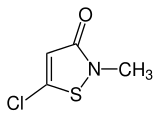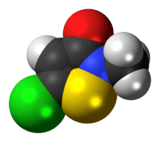Methylchloroisothiazolinone
Methylchloroisothiazolinone, also referred to as MCI, is a preservative with antibacterial and antifungal effects within the group of isothiazolinones. These compounds have an active sulphur moiety that is able to oxidize thiol-containing residues, thereby effectively killing most aerobic and anaerobic bacteria.[1] Methylchloroisothiazolinone is effective against gram-positive and gram-negative bacteria, yeast, and fungi.
 | |
 | |
| Names | |
|---|---|
| IUPAC name
5-Chloro-2-methyl-1,2-thiazol-3(2H)-one | |
| Other names
5-Chloro-2-methylisothiazol-3(2H)-one 5-Chloro-2-methyl-4-isothiazolin-3-one Chloromethylisothiazolinone Chloromethylisothiazolone Methylchloroisothiazolinone Methylchloroisothiazolone CMI CMIT MCI MCIT | |
| Identifiers | |
3D model (JSmol) |
|
| 1210149 | |
| ChEBI | |
| ChemSpider | |
| DrugBank | |
| ECHA InfoCard | 100.043.167 |
| EC Number |
|
PubChem CID |
|
| UNII | |
CompTox Dashboard (EPA) |
|
| |
| |
| Properties | |
| C4H4ClNOS | |
| Molar mass | 149.59 g·mol−1 |
| Appearance | Colorless liquid |
| Density | 1.02 g/cm³ |
| Miscible | |
| Hazards | |
| GHS pictograms |     |
| GHS Signal word | Danger |
GHS hazard statements |
H300, H301, H301, H310, H311, H314, H317, H318, H330, H331, H335, H400, H410 |
| P260, P261, P262, P264, P270, P271, P272, P273, P280, P284, P301+310, P301+330+331, P302+350, P302+352, P303+361+353, P304+340, P305+351+338, P310, P311, P312, P320, P321, P322, P330, P333+313 | |
Except where otherwise noted, data are given for materials in their standard state (at 25 °C [77 °F], 100 kPa). | |
| Infobox references | |
Methylchloroisothiazolinone is found in many water-based personal care products and cosmetics.[2] Methylchloroisothiazolinone was first used in cosmetics in the 1970s. It is also used in glue production, detergents, paints, fuels, and other industrial processes. Methylchloroisothiazolinone is known by the registered tradename Kathon CG when used in combination with methylisothiazolinone.[3]
Methylchloroisothiazolinone may be used in combination with other preservatives including ethylparaben, benzalkonium chloride, and bronopol.
Safety
Methylchloroisothiazolinone can cause allergic reactions in some people.[4] The first publication of the preservative as a contact allergen was in 1988.[5] Cases of photoaggravated allergic contact dermatitis, i.e. worsening of skin lesions after sun exposure, have also been reported.[4]
In pure form or in high concentrations, methylchloroisothiazolinone is a skin and membrane irritant and causes chemical burns. In the United States, maximum authorized concentrations are 15 ppm in rinse-offs (of a mixture in the ratio 3:1 of 5-chloro-2-methylisothiazol 3(2H)-one and 2-methylisothiazol-3 (2H)-one).[6] In Canada, methylchloroisothiazolinone may only be used in rinse-off products in combination with methylisothiazolinone, the total concentration of the combination may not exceed 15 ppm.[7]
As of 2008, the International Agency for Research on Cancer (IARC), did not list methylchloroisothiazolinone as a known, probable, or possible human carcinogen,[8] nor have in vivo tests found evidence of carcinogenic activity.
References
- Collier; et al. (1990). "Growth inhibitory and biocidal activity of some isothiazolone biocides". Journal of Applied Bacteriology. 69 (4): 569–577. doi:10.1111/j.1365-2672.1990.tb01550.x. PMID 2292520.
- Reinhard; et al. (2001). "Preservation of products with MCI/MI in Switzerland". Contact Dermatitis. 45 (5): 257–264. doi:10.1034/j.1600-0536.2001.450501.x. PMID 11722483.
- Knudsen BB, Menne T (1990). "Kathon CG--a new contact sensitizing preservative". Ugeskrift for Lægerer. 152 (10): 656–657. PMID 2321281.
- Pirmez, R.; Fernandes, A.L.C.; Melo, M.G.M. (2015). "Photoaggravated contact dermatitis to Kathon CG (methylchloroisothiazolinone/Methylisothiazolinone): A novel pattern of involvement in a growing epidemic?". British Journal of Dermatology. 173 (5): 1343–1344. doi:10.1111/bjd.13986. PMID 26130214.
- De Groot, A. C.; Weyland, J. W. (1988). "Kathon CG: A review". Journal of the American Academy of Dermatology. 18 (2 Pt 1): 350–358. doi:10.1016/s0190-9622(88)70051-1. PMID 3279090.
- "Annex VI release - 26 November 2017 - 201703" (PDF). U.S. Food and Drug Administration.
- "Cosmetic Ingredient Hotlist: Prohibited and Restricted Ingredients". Health Canada. 18 June 2004. Retrieved 15 February 2020.
- "International Agency for Research on Cancer". IARC (updated November 2007). Retrieved 7 January 2008.